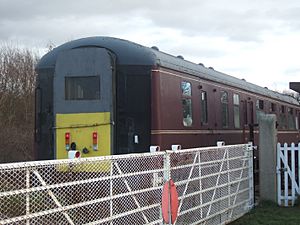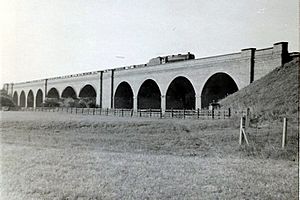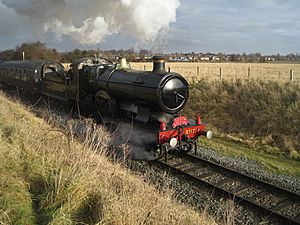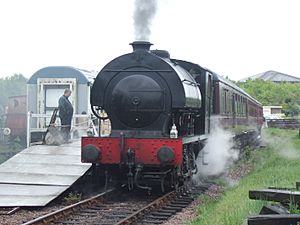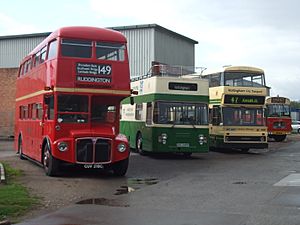Great Central Railway (Nottingham) facts for kids
Quick facts for kids Great Central Railway (Nottingham) |
|
|---|---|
 |
|
| Locale | Nottingham Transport Heritage Centre, Nottinghamshire, England |
| Terminus | Ruddington Fields |
| Commercial operations | |
| Built by | Edward Watkin Manchester, Sheffield and Lincolnshire Railway |
| Original gauge | 4 ft 8 1⁄2 in (1,435 mm) standard gauge |
| Preserved operations | |
| Stations | 2 |
| Length | 10 miles (16 km) |
| Preserved gauge | 4 ft 8 1⁄2 in (1,435 mm) standard gauge |
| Preservation history | |
| Headquarters | Nottingham Transport Heritage Centre |
| Website | |
| https://gcrn.co.uk/ | |
The Great Central Railway (Nottingham) is a special railway where old trains are kept and run. It's located at the Nottingham Transport Heritage Centre (NTHC) in Ruddington, Nottinghamshire. This railway uses almost 10 miles (16 km) of an old main line that once belonged to the Great Central Railway. It also has a branch line that goes to Ruddington Fields station. This station is on a former Ministry of Defence site, right next to Rushcliffe Country Park.
You can visit stations at Ruddington Fields and Rushcliffe Halt. There's also an old platform at East Leake, but trains don't stop there anymore.
This railway is separate from the Great Central Railway in Loughborough. However, there are big plans to connect the two lines again by bridging the "Loughborough Gap." This is a huge building project that started a while ago and is expected to finish between 2024 and 2028. Some parts of the line were used by trains carrying gypsum until early 2020.
Contents
How the Railway Was Saved
Saving the Old Railway Line
After the main Great Central Railway line closed in 1966, a small part from Nottingham to Rugby stayed open until 1969. People who loved old trains wanted to turn this into a heritage railway. But they couldn't get enough money, except for a section from Loughborough to Belgrave and Birstall.
British Rail kept a rail connection from Loughborough to the Ruddington Ministry of Defence (MoD) depot. When the MoD depot closed, about 2.77 miles (4.46 km) of track from East Leake to Ruddington was no longer needed. A group called the GCR Northern Development Association was formed. Their goal was to connect the two parts of the old Great Central Railway again.
Building the Heritage Centre
At first, they focused on fixing Rushcliffe Halt station. Then, Nottinghamshire County Council, which owned the old MoD site, agreed to let the Association use 12 acres. This led to the big idea of the Nottingham Transport Heritage Centre. It would not only save railways but also other types of transport history from the area.
In the 1990s, most of the work on what became the Great Central Railway (Nottingham) happened at Ruddington. It was hard to buy the line because of changes in who owned the railway tracks. Luckily, a company called British Gypsum wanted to start sending freight trains again. This helped the GCR(N) buy the line and get it ready for trains.
Challenges and Reopening
At East Leake station, houses were built very close to the tracks in the 1980s. The people living there thought the line was closed, but it wasn't. When the GCR(N) asked for permission to buy and run the line, some local residents objected. Because of this, passenger trains can only run through East Leake station at certain times, and the station itself remains closed.
To allow freight trains to use the line during the week and heritage trains on weekends, a small section of rail north of East Leake was removed. This created two separate railways. However, this "rail break" meant the GCR(N) couldn't easily reach Rushcliffe Halt. This has since been fixed with a new system. Even though the GCR(N) owns the full line, they still need permission from Network Rail to run trains to East Leake or Loughborough.
Regular services to Rushcliffe Halt started again in 2003. Passenger trains also ran further south to a place called "Loughborough High Level," even though there wasn't a station there.
Recent Changes and Reopening
In 2021, the "Great Central Railway (Nottingham)" was temporarily renamed the "Nottingham Heritage Railway." This happened after a railway safety group asked them to improve how they checked and fixed bridges and tunnels. There were also some disagreements between the groups preserving the two parts of the original Great Central Main Line.
After an agreement in 2023, the railway went back to its original name, "Great Central Railway (Nottingham)." The goal was to get heritage trains running again. The line from Ruddington to Rushcliffe Halt reopened to the public on Saturday, November 30, 2024, with a special "Jingle Bell Express" train. As of 2025, the line is fully open. Trains run to the A60 bridge for special events and to Rushcliffe Halt on normal days.
Exploring the Railway Route
Ruddington Fields: The Main Hub
Ruddington Fields is the main station and the heart of the Great Central Railway (Nottingham). Here, you'll find a building for road transport, sheds for locomotives, an old signal box, and miniature and model railways. There are also facilities for visitors. The Rushcliffe Country Park surrounds the railway area. A new platform opened in 2009, and another one is planned.
Asher Lane Crossing
The Asher Lane Crossing is on a private road that used to be part of the MoD depot. It's a short walk from the Country Park. You can watch trains pass and see the crossing keeper at work. There used to be sidings (extra tracks) here, but they have been removed.
Fifty Steps Bridge
Fifty Steps Bridge is where the branch line from Ruddington Fields ends. Trains often reverse here to continue their journey towards Loughborough. The bridge originally had "Fifty Steps," but more steps have been added over time. The old Ruddington station is further north, but it's now overgrown and part of a cycle path.
Journey South
Once on the main line, the train crosses Gotham Moor, offering nice views. It then passes the old Gotham branch-line, which was a short freight line that closed in 1969. This branch used to serve a gypsum mine.
Rushcliffe Halt Station
Rushcliffe Halt railway station is named after the nearby golf club. It opened in 1911 and is different from other stations because it has two separate platforms. Volunteers from the local area have been slowly restoring and caring for it. Near the station, at Hotchley Hill, is the British Gypsum works. An Art Deco signal box from the 1940s is also here. It has been restored, and there are plans to update the track layout for when the two railway lines connect again.
The original station near East Leake village is no longer used. It's just an island platform with the entrance to its subway bricked up.
Barnstone Tunnel and Beyond
Barnstone Tunnel is 98 yards (90 meters) long and is the only tunnel on this preserved line. It was built by hand a long time ago. There used to be more sidings near the tunnel, which could be put back in the future. Between the tunnel and Loughborough, the railway follows a ridge with views of the Soar Valley. The line crosses the River Soar on the Stanford Viaduct.
The Great Central Railway (Nottingham) trains stop near the A60 road. Beyond that is the connection to Network Rail and the Midland Main Line. The sheds of the Great Central Railway at Loughborough are about 1 mile (1.6 km) away. Plans to reconnect the two parts of the preserved GCR are well underway. A new bridge across the Midland Main Line, a refurbished canal bridge, and a new A60 bridge are all finished. More money is being raised for the next steps.
Once the two preserved sections are connected, the railway will be over 18 miles (29 km) long! The GCR is raising money for the next two stages, including the "Factory Flyover," for which over £1.25 million has been raised.
Railway Collection
The railway runs classic steam and diesel trains to Rushcliffe Halt and Loughborough. Most trains are run using a heritage DMU (Diesel Multiple Unit), but there's also a large collection of classic diesel locomotives. The site also has several old shunting locomotives.
Locomotives
- Steam Locomotives
- Andrew Barclay 1245 "Carron No.14"
- Manning Wardle 0-6-0ST No. 1762 "Dolobran", built in 1910 (Being restored)
- LNER Thompson B1 No.1264 (Being overhauled)
- Main Line Diesel Locomotives
- Class 20 Bo-Bo No. 20154 (Operational)
- Class 31 A1A-A1A No. 31463 (Being overhauled)
- Class 37 Co-Co No. 37340 (Being restored)
- Diesel Shunters
- Ruston and Hornsby 165 0-4-0DE 449754 "Staythorpe 2B" (Being overhauled)
- Ruston and Hornsby 88DS 263001 "Staythorpe 2A" (Operational)
- Sentinel 0-6-0DH No. H014 (Being repaired)
- Class 03 0-6-0DM No. D2118 (Being overhauled)
- Class 08 0-6-0DE No. 08114 (Operational)
- Class 08 0-6-0DE No. 08220 (Operational)
- Class 08 0-6-0DE No. 08784 (Operational)
- Class 08 0-6-0DE No. 08694 (Operational)
- Diesel Multiple Units
- BR Class 108 unit 53645+53926 (Being restored)
- BR Class 116 hybrid unit 51138+59501+51151 (Being overhauled)
- BR Class 144 unit 144003
Carriages
- BR Mk1 Carriages
- Mk1 RMB (Restaurant Miniature Buffet) 1811 (Being overhauled)
- Mk1 CK (Composite Corridor) 16168 (Operational)
- Mk1 CK (Composite Corridor) 16190 (Operational)
- Mk1 TSO (Tourist Standard Open) 4207 (Operational)
- Mk1 RSO (Restaurant Second Open) 1012, later Cinema Coach 150353 (Stored)
- BR Mk2 Carriages
- Mk2 BSO (Brake Standard Open) 9389 (Operational)
- Mk2a TSO 5365 (Stored, waiting to be removed)
- Mk2a TSO 5376 (Stored, waiting to be removed)
- Mk2b TSO 5497 (Stored, waiting to be removed)
- Mk2a BSK 35512 (Stored, overhaul stopped)
- GCR Barnum Carriages
- GCR Barnum dining coach 664 (Stored)
- GCR Barnum brake coach 695 (Stored)
- GCR Barnum Dining coach 666 (Stored) (This is the only original GCR coach owned by the National collection)
- GCR Barnum bar coach 228 (Being restored indoors)
- Other Carriages
- GCR Clerestory brake coach 1663 (Stored)
- GCR Suburban brake coach 555 (Stored)
- GCR Suburban composite coach 799 (Stored)
- Non-Passenger Carrying Stock
- BR Mk1 GUV (General Utility Van) 86565 (Stored)
- BR Mk1 GUV (General Utility Van) 86129 (Operational)
Wagons
- Brake Vans
- BR 20-ton brake van 952282 built in 1954 (Stored, waiting overhaul)
- Shark ballast brake van DB993874 (Being overhauled)
- LMS 20-ton brake van 357771 built in 1927 (Waiting for overhaul to restart)
- Vans
- BR Palvan 779761 built in 1958 (Painted army green)
- BR Widefit 784455 built in 1962 (Painted BR Bauxite)
- BR 29-ton VAA 200631 built in 1976
- BR Palvan 778771 built in 1959 (Painted BR Bauxite)
- BR Palvan 776155 built in 1957 (Painted army green)
- BR Palvan 782111 built in 1960 (Painted army green)
- Railfreight Pressed Steel box van 786902
- Railfreight Pressed Steel box van 201055
- BR Ferry van 786902 built in 1962
- Ballast Wagons
- BR Dogfish ballast hopper wagon 993039 built in 1959 (Operational)
- BR Dogfish ballast hopper wagon 983586 built in 1960 (Operational)
- BR Dogfish ballast hopper wagon 993597 built in 1959 (Operational)
- BR Dogfish ballast hopper wagon 993230 built in 1957 (Operational)
- BR Grampus open wagon 991831 built in 1958 (Operational)
- Flat Wagons
- LMS 50-ton Warwell 721218 built in 1949 (Operational)
- BR Weltrol 900936 built in 1960 (Operational)
- LNER 22-ton Lowmac wagon 230964 (Operational)
- BR Bogie bolster wagon 943545 built in 1953
- BR Bogie rail sturgeon A 994271 built in 1956
- BR Bogie rail sturgeon A 994770 built in 1953
- Brake van 900937 built in 1960, a special wagon for carrying smaller railway vehicles
GCR Rolling Stock Trust
A charity called the GCR Rolling Stock Trust, based at the Great Central Railway (Nottingham), owns one of the largest collections of old railway carriages in the UK. These carriages were built before the main railway companies merged. This collection includes the famous 'Barnum' carriages, which were used by P.T. Barnum's traveling circus. Some items are even older, from the time when the Great Central Railway was called the Manchester, Sheffield and Lincolnshire Railway.
- Six Wheeler GCR No 946: This carriage is fully restored and displayed at the Mountsorrel & Rothley Heritage Center Museum shed.
- Barnum Bar coach No 228 built in 1910: This is one of the group's restoration projects.
- Barnum Brake Coach No 695 built in 1910: Waiting to be restored.
- Barnum Open Saloon No 666 built in 1910: Waiting to be restored. It has been moved to Swithland Sidings on the other GCR site.
- Barnum Open Saloon No 664 built in 1910: Waiting to be restored.
- Clerestory 1st and 3rd class No 1663: Waiting to be restored.
- Suburban No 799: This carriage is outside, has a good frame, and its roof has recently been covered to protect it from the weather.
- Suburban GCR Coach No 555: Separated from its frame.
- Six Wheeler No 373 GCR: Stored with a poor body, needing major work on its frame.
Another GCR suburban coach from 1905, No.793, is not part of the Trust's collection but is looked after by the GCR 567 Group. It's stored at Swithland Sidings and is in very poor condition, covered for weather protection.
Nottingham Area Bus Society
The Nottingham Transport Heritage Centre also hosts the Nottingham Area Bus Society. This group has a large collection of old buses that have been restored and maintained. These buses used to operate for local bus companies. You can sometimes take bus rides during special events, and the bus collection is open to view on the railway's open days.
- Operational Vehicles
- Barton Transport AEC Regent V 854 FNN, built in 1960.
- Barton Transport Leyland PD1 JVO 230, built in 1947.
- Barton Transport Leyland PS1/1 WAL 782, built in 1948.
- Barton Transport Leyland Leopard XRR 615M, built in 1973.
- Barton Transport Bedford YMT RRR 517R, built in 1976.
- Nottingham City Transport AEC Regent III OTV 161, built in 1954.
- Nottingham City Transport Leyland Atlantean ARC 666T, built in 1978.
- Midland General Bristol MW DNU 20C, built in 1965.
- Midland General Leyland National XRB 415L, built in 1972.
- Northern General Leyland Atlantean ORC 545P, built in 1976. (An open-top bus, painted in Trent red and cream).
- Leicester City Transport Leyland PD1 DJF 349, built in 1946. (Operational, but still being restored).
- Felix Bus Services Bedford SB1 618 KRA, built in 1959.
- Non-Operational Vehicles
- Barton Transport AEC Reliance DAL 771J, built in 1970. (Being repaired).
- Barton Transport Leyland Leopard HAL 703J, built in 1970. (Being restored).
- Barton Transport Leyland PD1 KNN 254, built in 1949. (Being overhauled).
- Barton Transport Leyland BTS1 VVO 735, built in 1957. (Being restored).
- South Notts Leyland Lion LT5 VO 8846, built in 1933. (Stored, waiting restoration).
- South Notts Leyland Royal Tiger PSU1/11 MAL 310, built in 1951. (Being restored).
- Trent Buses Volvo Citybus B10M-50 F609 GVO, built in 1989. (Being restored).


